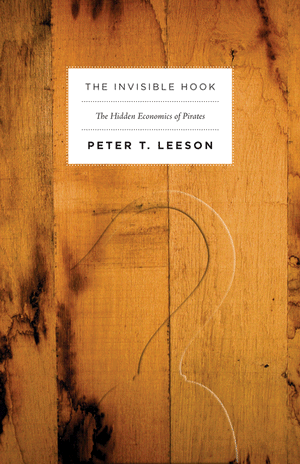
The Invisible Hook: The Hidden Economics of Pirates
by Peter T. Leeson
-Reviewed by Monica Barra
Until pirates started raiding ships off the Somali coast, Johnny Depp as Captain Jack Sparrow from the Pirates of the Caribbean trilogy was the epitome of the swashbuckling, treasure-seeking, barbarous pirate. Like most people, Peter T. Leeson has childhood fascination with the Sparrow sort of pirate, but, as an economist, Leeson can shed light on another, unexpected quality of their lives: pirates, he argues, adhered to codes and ethics not so different from those of land-faring people. The Invisible Hook manages to recognize the myths of piracy while giving serious consideration to the logistics, both social and economic, of a life of adventure and plunder on the high seas in the 17th and 18th centuries.
Instead of focusing on the differences between pirates and the people they attack, Leeson draws out the similarities between democratic societies and the world of piracy. He begins by extending Adam Smith’s “invisible hand” theory to the economies of pirates. Leeson makes a simple yet critical connection, “Smith’s invisible hand is as true for criminals as it is for anyone else, although criminals direct their cooperation at someone else’s loss.” Our land-based economy cannot survive with individuals working entirely alone for personal benefit, and neither can a pirate economy. Leeson points out that pirates must work together to benefit from, as he aptly names it, the invisible hook.
The invisible hook, Leeson writes, led pirates in the 17th and 18th centuries to create democratic and ethical codes that had uncanny resemblances to the constitutional democracies crafted during the same era. While captains acted like kings on merchant ships, pirates crafted their societies around maximizing profit for everyone, and cooperation was the only way to secure it. Democratic codes created solidarity among them, giving each man equal representation and power for deciding everything from who was captain to how to divide up booty. Some codes even articulated how to pay out insurance to pirates injured on the job, and how to vote out a dishonorable captain. It was a far cry from the merchant ships, whose captains acted like kings.
Even the best-known stereotypes of pirates fit into Leeson’s economic theories, as examples of pirates’ “signaling” and “branding” to secure booty with minimal cost. The greatest of these signals was the Jolly Roger, the famed skull and cross-bones flag. “The Jolly Roger, then, signaled ‘pirate,’” Leeson writes, “which meant two things. ‘If you resist us, we’ll slaughter you. If you submit to us peacefully, we’ll let you live.’” The flag, along with the barbaric reputation it carried, enabled pirates to exercise power over mercantile ships with little effort, albeit with sometimes incredibly cruel punishment. Most of the time, however, crews submitted peacefully, relieving pirates of the trouble of fighting.
Whenever pirates did have to live up to their reputations, as Leeson explains, they had stipulations to follow. Torture was one of the acts significantly regulated by pirate code, primarily used for three main reasons, according to Leeson: to gain information, especially about treasure on captured ships; to punish government officials in retaliation for capturing or executing other pirates; and to punish abusive merchant captains. Pirates were merciless to those who did not surrender or cooperate, but were surprisingly humane to those who knew better than to challenge the Jolly Roger.
Going further into the dynamic culture and society of piracy, Leeson discloses some surprising facts about pirate conscription. Forcing merchant sailors to either “join the pirate crew or die,” Leeson tells us, was the exception and not the rule to pirate recruitment. More often then not, the economic benefits of joining a pirate ship outweighed the costs of remaining a lowly merchant crew member. Furthermore, Leeson sheds light on pirates’ progressive and profitable approach to racial tolerance, capitalizing on the economic benefits of having black men on their ships and sometimes even granting them equal rights.
The Invisible Hook reconciles the world of pirates and men by applying what we understand about democratic society, justice, and, ultimately, economics, to piracy. Leeson does the work of economist at a level that does not require fluency in economic theory. He writes with awe and respect for piracy, reconciling a childhood fascination with a mature and informed understanding of these rebellious seamen.
Excerpt: “Pirate fiction portrays seamen as choosing piracy out of romantic, if misled, ideals about freedom, equality, and fraternity. While greater liberty, power sharing, and unity did prevail aboard pirate ships, these were piratical means, used to secure cooperation within pirates’ criminal organization, rather than piratical ends, as they’re often depicted.”
Further reading: False Economy: A Surprising Economic History of the World and Under the Black Flag: The Romance and the Reality of Life Among the Pirates
.




Send A Letter To the Editors